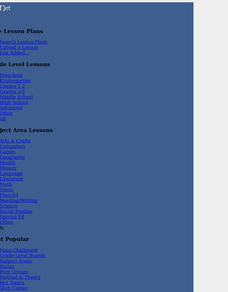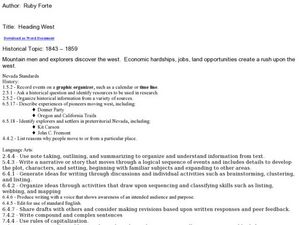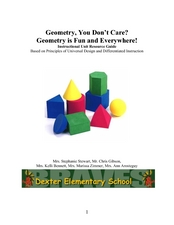Curated OER
Mini-Ponds
In this mini pond worksheet, learners create a mini-pond ecosystem with soil, water, and plant life. Students let their ecosystem sit for a day and they observe a sample the next day. Learners identify all the pond water microorganisms...
Curated OER
Awesome authors (Elementary, Reading/Writing)
Fifth graders use technology to research and collect data. They develop awareness and appreciation of authors and genres. They organize information for presentation.
Alabama Learning Exchange
Do You Have a Babushka?
Young scholars retrieve information about Patricia Polacco from selected sources. They classify information into prescribed categories on a concept map.
Curated OER
Plants, Animals and Our Environment
Students draw and label the basic needs of animals. They draw and label the basic needs of plants. Students understand the basic needs of plants and animals are not only the same, but are interrelated. They know that the environment...
Curated OER
Living and Nonliving Environments
In this ecosystem worksheet, students will distinguish between the abiotic factors and biotic factors shown in a diagram. Then students will correctly order the following: population, ecosystem, community, and organism.
Curated OER
Levels of Classification
Students use diagrams to compare structural differences that taxonomists use to classify animals. For this classification lesson plan, students compare structures of different species from given diagrams. In one diagram they identify the...
Curated OER
Heading West
Students study the concept of the westward expansion. In this exploration of the western U.S. lesson, students participate in different activities that explain economic hardships, jobs, and land opportunities. Students describe...
Curated OER
Creating and Outline From Research
Fourth graders develop 3 research questions about a topic they choose and categorize the information they have learned. In this research lesson plan, 4th graders use a variety of non fiction materials from the library.
Curated OER
Animals, Animals, Everywhere
Fourth graders participate in a variety of activities dealing with animal characteristics and classifications in this multi-task lesson. They use graphic organizers, make booklets, and make models.
Curated OER
Coming to America
Fifth graders listen to the song America by Neil Diamond, view pictures of Ellis Island, and role play as processing officers who evaluate, classify and recommend which immigrants can stay in America.
Curated OER
Rocks and Minerals
Students are able to describe earth processes (e.g., rusting, weathering, erosion) that have affected selected physical features in students, neighborhoods. They are able to identify various earth structures (e.g., mountains, faults,...
Curated OER
Geometry is Fun and EverywhereGeometry, You Don’t Care? Geometry is Fun and Everywhere
Third graders investigate shapes in our world. In this geometry lesson plan, 3rd graders describe plane and solid shapes and identify angles, solid objects and lines of symmetry. Students use online resources, graphic organizers and...
Curated OER
Reading the River - Biological Classification
Youngsters create a list of grocery store items and then work together to categorize them as if they were setting up the shelves of the market. Then they are given a box of miscellaneous objects to practice categorizing. With these two...
Curated OER
How Can You Group Matter?
In this matter worksheet, students will categorize and classify different types of matter as either a solid, liquid, or gas. This worksheet is a graphic organizer.
Curated OER
2-D and 3-D Presents at Pedro's Party
Fifth graders draw 2-D and 3-D shapes. They sketch and label geometric figures with correct terminology, then explore parallel and perpendicular lines. Pupils sort and classify shapes drawn.
Curated OER
KWL Chart
In this KWL chart worksheet, students fill out a graphic organizer about what they know, what they want to know, and what they learned about a given subject.
Curated OER
What Animals Are Mammals And Birds?
In this classification worksheet, students will brainstorm animals and list them on the graphic organizer as either a mammal or a bird.
Curated OER
What Are Nonliving Parts of Ecosystems?
In this ecosystem worksheet, students brainstorm the nonliving things found in a desert ecosystem and a polar ecosystem. This worksheet is a graphic organizer.
Curated OER
How Do We Use Water?
In this water use worksheet, students brainstorm different ways people use water and then complete 3 fill in the blank statements about how people can keep water clean. This worksheet is a graphic organizer.
Teach Engineering
Alloy Advantage
Mix it up by using an intriguing resource that teaches young metallurgists that alloys are a metal mixture. They learn about the advantages of using alloys over pure metals and investigate titanium alloys as an example to finish the...
Virginia Department of Education
Quadrilateral Sort
If only you had a Sorting Hat to sort out quadrilaterals. Learners sort cutouts of quadrilaterals based on their properties and attributes. A flowchart helps them organize the results of the activity.
Council for the Curriculum, Examinations and Assessment
Morals, Values and Beliefs
Your personality is based on the things you believe in, the morals you abide by, and the values upon which you make your decisions. Delve into a set of lessons about values and moral framework with your eighth graders as they explore and...
University of Delaware
Constructing Text-Based Arguments About Social Issues
Eighth graders take a stand on a variety of controversial topics with a lesson on argumentative writing. As they view an informative presentation and work with collaborative groups, they decide which side of each argument they want to...
Benjamin Franklin High School
Saxon Math: Algebra 2 (Section 1)
This first of twelve algebra 2 resources provides a broad review of many algebra 1 concepts through a number of separable lessons and labs. Starting with the real number system and its subsystems, the sections quickly but thoroughly move...

























